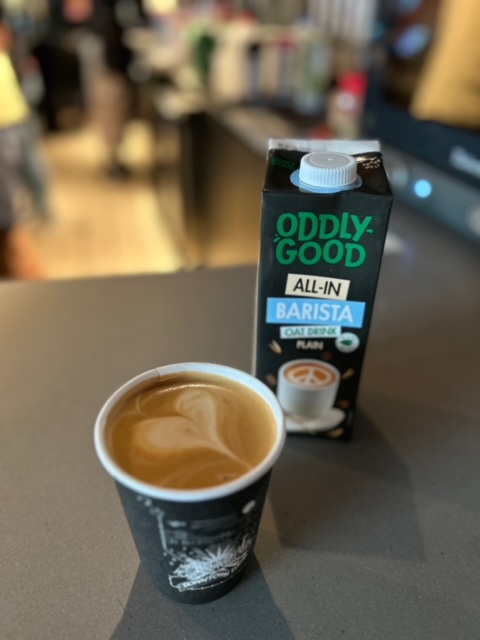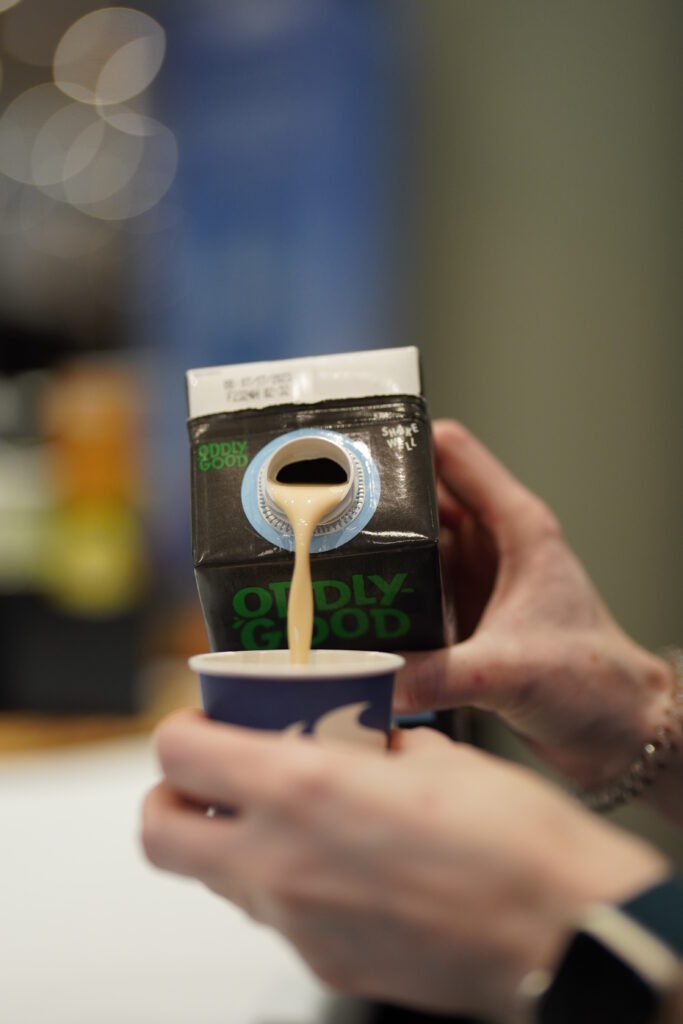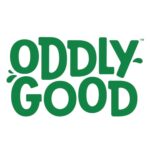This article is sponsored by our partner, Oddlygood.
While dairy milk remains a champion for milk steaming and latte art, plant-based alternatives are steadily winning the hearts of coffee consumers. Many people have become more conscious of the environmental and ethical issues tied to dairy production, prompting them to opt for non-dairy alternatives—like soy, almond, oat, and coconut milk—in their coffee drinks. As a result, global sales of alternative milks surged by 19% between 2020 and 2022, while conventional dairy sales have seen a decline of 9%.
However, steaming and pouring beautiful latte art is a whole different ball game with alternative milk options versus dairy. Many baristas are all too familiar with the screeching symphony during steaming or the frustration of trying to pour latte art with unstable foam.
As more customers embrace non-dairy alternatives, baristas face the challenge of learning how to steam various types of milks, especially since many alternatives steam and pour wildly differently from one another. But knowledge is power, and by familiarizing themselves with the unique characteristics of each non-dairy milk, baristas can continue crafting top-notch coffee drinks and pouring exceptional latte art that delights.
The Science Behind Steamability
Before diving into alternative milks, we need to talk about exactly why dairy milk steams like a dream and how the different components of dairy milk interact during the steaming process.
Dairy milk is a homogenized mixture of mainly water followed by fat, protein, carbohydrates, and minerals. “Fat varies depending on the type of milk: whole milk at 3.25%, skim milk at 2%, low-fat milk at 1%, and non-fat milk (less than 0.5%),” says Brian Chau, principal at Chau Time, an R&D and operations consulting firm for the consumer packaged goods and foodservice industry. “Proteins are mostly whey (water soluble) and casein (fat-soluble), [and] carbohydrates as sugars are mostly in the form of lactose.”

Making the perfect microfoam for latte art involves heating and aerating milk to create a delicate milk foam that looks like wet paint. Each of the elements in milk—namely, fats, proteins, and lactose—reacts differently to heat, shaping the foam’s texture and taste. Fat content determines the richness and thickness of your milk foam. Milk with a lower fat content produces a stiff foam similar to shaving cream, making it challenging to pour latte art.
High-fat milk, like whole milk, creates a thicker, more flavorful microfoam. Lactose (the sugars in milk) isn’t very sweet when cold, but as it warms up and melts, it creates the quintessential sweet steamed milk. “Some of the water vapor will interact with lactose, which can cause a Maillard browning reaction [which brings out] complex and great flavor notes,” explains Chau, referencing a chemical reaction that uses heat to transform proteins and sugars.
Milk’s proteins are foam stabilizers, so the more protein, the more stable the foam. As the milk heats up during the steaming process, the milk’s caseins will start to denature (break down) and form a protective shield around the air bubbles.
Fat varies depending on the type of milk: whole milk at 3.25%, skim milk at 2%, low-fat milk at 1%, and non-fat milk (less than 0.5%). Proteins are mostly whey (water soluble) and casein (fat-soluble), [and] carbohydrates as sugars are mostly in the form of lactose. brian chau
“Because casein is fat soluble, the fat in the milk will interact with the casein and form a matrix or a foam,” says Chau. “The technique of creating a foam also requires some agitation to evenly distribute some of the water vapor (gas molecules) such that there is not a thick head of foam on top.” With the sweetness from melted lactose and the thickness from the fats, you get dairy milk’s distinct sweet and dense microfoam—the perfect canvas for latte art.
The Alternative Version
Steaming non-dairy milk to achieve the perfect microfoam for latte art can be challenging, often leading to weak, too bubbly, or curdled foam. These things happen mainly because of the varying protein and fat levels in non-dairy milk, making them more heat-sensitive than dairy milk.

Non-dairy milk is a colloid (homogenous mixture) that results from fully emulsifying (mixing) plant-based substances such as almonds, soy, or oats with water. Alt-milk manufacturers use emulsifiers, like xanthan gum in almond milk, to make them more shelf-stable. Since emulsifiers prevent fat separation in water, they can produce a creamier, more stable milk foam. However, Chau says these emulsifiers can sometimes alter the milk’s taste and texture when heated.
Typically, non-dairy milks stay emulsified, but exposure to high heat or acidity (like coffee) can break the emulsion, causing the milk to coagulate and curdle. Ben Ryan has been a barista for over seven years—he’s now a barista lead at Story and Soil Coffee in Middletown, Connecticut—and he says this is one reason he dislikes steaming soy milk. “I find that the proteins [in soy milk] have no tolerance for heat and begin to denature and curdle almost immediately,” he says.
So, while dairy milk can handle steaming temperatures between 131°F (55°C) and 149°F (65°C), many non-dairy milks fare better at lower temperatures. The ideal temperature for steaming alternative milks, especially oat milk, is around 149°F (60°C), says Caitlin Mahler, head of business development at Oddlygood USA. Lowering the temperature slows down the rate at which the proteins in non-dairy milk denature and coagulate. However, lower temperatures can also make alternative milks taste sweeter, which might not work well for all milk-based coffee drinks.
Non-dairy milks all behave differently, and not all brands share the same formulation to consistently achieve high-quality microfoam, says Chau. Ryan agrees, sharing how, from his experience, some milks are harder than others to steam: “Coconut milk can tolerate heat better, but it’s [more challenging] to pour latte art with because it is too oily and tends to get super bubbly,” he says. “Nut milks are better but are extremely finicky. They don’t have a high tolerance for adding air, and also can denature at high temperatures.”
Weighing Your Options
Although dairy milk has reigned supreme for latte art, many non-dairy milks are becoming top contenders for creating latte art. Soy, almond, and coconut milk are popular among baristas for their varying tastes and textures. Steamed soy milk offers creaminess and a mild, nutty flavor without overpowering the coffee’s taste. Steaming almond milk produces a thinner microfoam, sometimes causing a bitter aftertaste that can mask the taste of the coffee. Coconut milk has a much heavier mouthfeel than almond milk and can create a sweeter, glossy foam. Other less common alternatives include cashew, macadamia nut, and hemp milk.
Because of its density, Ryan says that oat milk is his favorite alternative to steam to achieve silky microfoam. “There are a lot of fats and carbs packed into it, and it approaches whole milk in terms of richness,” he says. “I find that when steaming milk, you need to be able to add a good amount of air in order to create a higher-quality microfoam, and oat milk has the highest tolerance for adding air.” Aleksi Kuusijärvi, Finnish Brewers Cup Champion, agrees, mentioning how oat milk steams most like full-fat dairy milk, making it easy to foam and ideal for pouring beautiful latte art.

“There are also new alternative milks engineered to steam [better], such as Myracle Kitchen Mylk or NotMilk,” says Ryan. “These steam well and are fun to work with, but customers are generally not familiar with them, and it can often be difficult to explain the ingredients.” Other emerging alternative milk brands like Oddlygood All-In Barista Oat Drink are also looking to elevate how oat milk steams. Mahler says they use every part of the oats to minimize waste and make the oat milk velvetier and richer when steamed. “Using the whole oat delivers a full-bodied, ’round’ taste. It is earthy, slightly sweet from the natural sugars in the oat, and not overpowering.”
Allan Flores, barista at J.René Coffee Roasters in West Hartford, Connecticut, describes his experience steaming Oddlygood All-In Barista Oat Drink: “The micro-foam was [easy] to achieve and felt much more like whole milk than other alternative milks. Most oat milk brands have a louder steaming process than most milks, but this brand of oat had a much quieter steaming.”
During the steaming and foaming process, baristas have to understand what temperature to set the water vapor to achieve a foam, if possible, based on fat and protein content of the non-dairy milk. Brian chau
“Oddlygood has a full body with a silky, smooth texture that coats and lingers in your mouth. The nutty flavor stands [out] against the espresso when mixed,” says Taki Tanaka, head barista at J.René Coffee Roasters. Since it has a darker color compared to other alternative milks, Tanaka says this provides a little less contrast for latte art. Kuusijärvi adds that this oat milk compliments, rather than overpowers, the espresso: “It balances the coffee flavors really nicely and also gives a nice soft mouth feel when you drink it.”
Steaming and Pouring like a Pro
It’s easy to achieve perfect milk foam for latte art with any non-dairy milk so long as you know how each behaves when steamed and poured. Firstly, using “barista edition” non-dairy milks designed specifically for milk steaming is helpful. Barista edition milks often include added stabilizers, fats, and sugars to emulate the qualities of dairy milk, making it easier to create high-quality microfoam. Ryan also recommends sticking to milk with a higher fat content to achieve a creamier foam. “Our Barista Oat Drink has a high enough fat content to create silky foam that doesn’t flake or collapse in your drink,” adds Mahler.
Temperature and time play vital roles when steaming non-dairy milk. “During the steaming and foaming process, baristas have to understand what temperature to set the water vapor to achieve a foam, if possible, based on fat and protein content of the non-dairy milk,” says Chau.
Each non-dairy milk also has its unique techniques for pouring latte art. Soy milk provides a stable foam but can get too foamy quickly, requiring more pitcher swirling and tapping for a smoother consistency. Since almond milk has a watery texture and loses its foam quickly, you must pour it immediately and with more control. Coconut milk may develop large bubbles, but you can achieve a glossy, fine microfoam with proper agitation.

Mahler also says you can steam their All-In Barista Oat Drink at both room temperature and cold. However, colder milk will give you more time to work on the foam texture. “[The] aim is to get rips of air in as soon as possible [because] milk takes in the air better when colder. Use the first five seconds for getting the air [into] the oat drink,” says Mahler. They also recommend stopping steaming it just before the milk pitcher becomes too hot to the touch for the ideal latte art foam.
Ryan gives some tips for pouring latte art with oat milk: “It tends to create thicker lines, so I find sticking to designs that work best with thick lines, such as a tulip or a slowsetta, work best.” Since the layer of foam on top of oat milk moves and plies easily, “you can pull the wings out on a piece very effectively, but if you aren’t careful, you can also end up pushing too much foam out of the way, and you end up pouring directly into the coffee.”
While dairy milk has long been the golden standard for creating the ideal microfoam for latte art, it’s undeniable that non-dairy alternatives are here to stay. Previously, non-dairy options struggled to match the texture, taste, and latte art potential of dairy milk. However, today’s non-dairy alternatives offer baristas and customers an impressive variety of textures and flavors that most certainly rival their dairy counterparts.

Sponsored by Oddlygood
Oddlygood’s All-In Barista Oat Drink is an oat-based milk alternative for professional baristas, designed to mimic the taste and foaming properties of traditional full-fat milk and suitable for both hot and cold drinks.
















